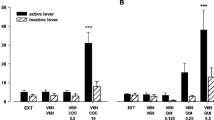Abstract
Rats with bilateral 6-OHDA-induced striatal lesions exhibit altered apomorphine-induced behavior compared to the typical response seen in intact rats. This response is characterized by stereotypic grooming behavior which is transformed to compulsive and intense biting at higher doses. Other agonists, pergolide, bromocriptine, N-n-propylnorapomorphine and L-dopa/carbidoa, caused the same response. Direct intrastriatal infusion of apomorphine after 6-OHDA-induced lesions of the striata also produced this response, while similar SKF 38393 infusion caused more licking than biting, directed at the abdomen instead of the forepaws. The dopamine receptor antagonists haloperidol, SCH 23390 and sulpiride effectively blocked apomorphine-induced behaviors in dopamine-depleted animals. This altered behavior was not observed in rats with dopamine depletion in nucleus accumbens (NAS), nor did additional NAS lesions in rats with existing striatal lesions affect the behavior. Further, high doses of apomorphine (up to 60 mg/kg) failed to induce stereotypic grooming in unlesioned rats. We therefore propose that altered apomorphine-induced behavior is a unique consequence of striatal dopamine depletion and not just an intense form of normal stereotypic activity.
Similar content being viewed by others
References
Breese GR, Baumeister AA, McGown TJ, Emerick SG, Frye GD, Crotty K, Mueller RA (1984) Behavioral differences between neonatal and adult 6-hydroxydopamine-treated rats to dopamine agonists: relevance to neurological symptoms in clinical syndromes with reduced brain dopamine. J Pharmacol Exp Ther 231:343–354
Burt DR, Creese I, Snyder SH (1977) Anti-psychotic drugs: chronic treatment elevates dopamine receptor binding in brain. Science 196:326–328
Creese I, Iversen SD (1973) Blockage of amphetamine induced motor stimulation and stereotypy in the adult rat following neonatal treatment with 6-hydroxydopamine Brain Res 55:369–382
Creese I, Burt DR, Snyder SH (1977) Dopamine receptor binding enhancement accompanies lesion-induced behavioral supersensitivity. Science 197:596–598
De Lean A, Munson PJ, Rodbard D (1978) Simultaneous analysis of families of sigmoidal curves: application to bioassay, radioligand assay, and physiological dose-response curves. Am J Physiol 235:97–102
DiChiara G, Morelli M (1984) Output pathways mediating basal ganglia function. In: McKenzie JS, Kemm RE, Wilcock LN (eds) Advances in behavioral biology, vol 27. Plenum Press 443–466
Erinoff L, Kelly PH, Basura M, Snodgrass SR (1984) Six-hydroxy-dopamine induced hyperactivity: neither sex differences nor caffeine stimulation are found. Pharmacol Biochem Behav 20:707–713
Glowinski J, Iversen LL (1966) Regional studies of catecholamines in the rat brain. J Neurochem 13:655–669
Hartgraves SL, Kelly PH (1983) Inhibition of drug-induced circling by GABA-ergic activity in the nucleus accumbens. Brain Res Bull 11:315–320
Horn AS, Cuello AC, Miller RJ (1974) Dopamine in the mesolimbic system of the rat brain: endogenous levels and the effects of drugs on the uptake mechanism and stimulation of adenylate cyclase activity. J Neurochem 22:265–270
Jackson EA, Neumeyer JL, Kelly PH (1983) Behavioral activity of some novel aporphines in rats with 6-hydroxydopamine lesions of caudate or nucleus accumbens. Eur J Pharmacol 87:15–23
Joyce JN (1983) Multiple dopamine receptors and behavior. Neurosci Biobehav Rev 7:227–256
Lesch M, Nyhan WL (1964) A familial disorder of uric acid metabolism and central nervous system function. Am J Med 36:561–570
Ljungberg T, Ungerstedt U (1976) Reinstatement of eating by dopamine agonists in aphagic dopamine denervated rats. Physiol Behav 16:277–283
Lloyd KG, Hornykiewicz O, Davidson K, Shannak K, Farley I, Goldstein M, Shibuya M, Kelley WN, Fox IH (1981) Biochemical evidence of dysfunction of brain neurotransmitters in the Lesch-Nyhan syndrome. N Engl J Med 305:1106–1111
Mandel RJ, Randall PK (1985) Quantification of lesion induced dopaminergic supersensitivity using the rotational model in the mouse. Brain Res 330:358–363
Marshall JF, Ungerstedt U (1977) Supersensitivity to apomorphine following destruction of the ascending dopamine neurons: quantification using the rotational model. Eur J Pharmacol 41:361–367
Molloy AG, Waddington JL (1984) Dopaminergic behaviour stereospecifically promoted by the D1 agonist R-SK & F 38393 and selectively blocked by the D1 antagonist SCH 23390. Psychopharmacology 82:409–410
Moore KE, Phillipson OT (1975) Effects of dexamethasone on phenylethanolamine N-methyltransferase and adrenaline in the brains and superior cervical ganglia of adult and neonatal rats. J Neurochem 25:289–294
Osterburg HH, Donahue HG, Severson JA, Finch CE (1981) Cate-cholamine levels and turnover during aging in brain regions of male C57BL/6J mice. Brain Res 224:337–352
Pellegrino LJ, Cushman AJ (1967) A stereotaxic atlas of the rat brain. Appleton-Century-Crofts, New York
Price TC, Fibiger HC (1974) Apomorphine and amphetamine stereotypy after 6-hydroxydopamine lesions of the substantia nigra. Eur J Pharmacol 29:249–252
Randall PK (1985) Quantification of dopaminergic supersensitization using apomorphine-induced behavior in the mouse. Life Sci 37:1419–1423
Rebec GV, Bashore TR (1984) Critical issues in assessing the behavioral effects of amphetamine. Neurosci Biobehav Rev 8:153–159
Schoenfeld R, Uretsky N (1972) Altered response to apomorphine in 6-hydroxydopamine-treated rats. Eur J Pharmacol 19:115–118
Umezu K, Moore KE (1979) Effects of drugs on regional brain concentrations of dopamine and dihydroxyphenylacetic acid. J Pharmacol Exp Ther 208:49–56
Ungerstedt U (1971) Adipsia and aphagia after 6-hydroxydopamine induced degeneration of the nigro-striatal dopamine system. Acta Physiol Scand Suppl 367:95–122
Yurek DM, Randall PK (1985) Simultaneous catalepsy and apomorphine-induced stereotypic behavior in mice. Life Sci 37:1665–1673
Author information
Authors and Affiliations
Additional information
SLH was an AFIT supported doctoral candidate. He is currently assigned to the School of Aerospace Medicine, Brooks A.F.B., Texas
Rights and permissions
About this article
Cite this article
Hartgraves, S.L., Randall, P.K. Dopamine agonist-induced stereotypic grooming and self-mutilation following striatal dopamine depletion. Psychopharmacology 90, 358–363 (1986). https://doi.org/10.1007/BF00179191
Received:
Revised:
Issue Date:
DOI: https://doi.org/10.1007/BF00179191




